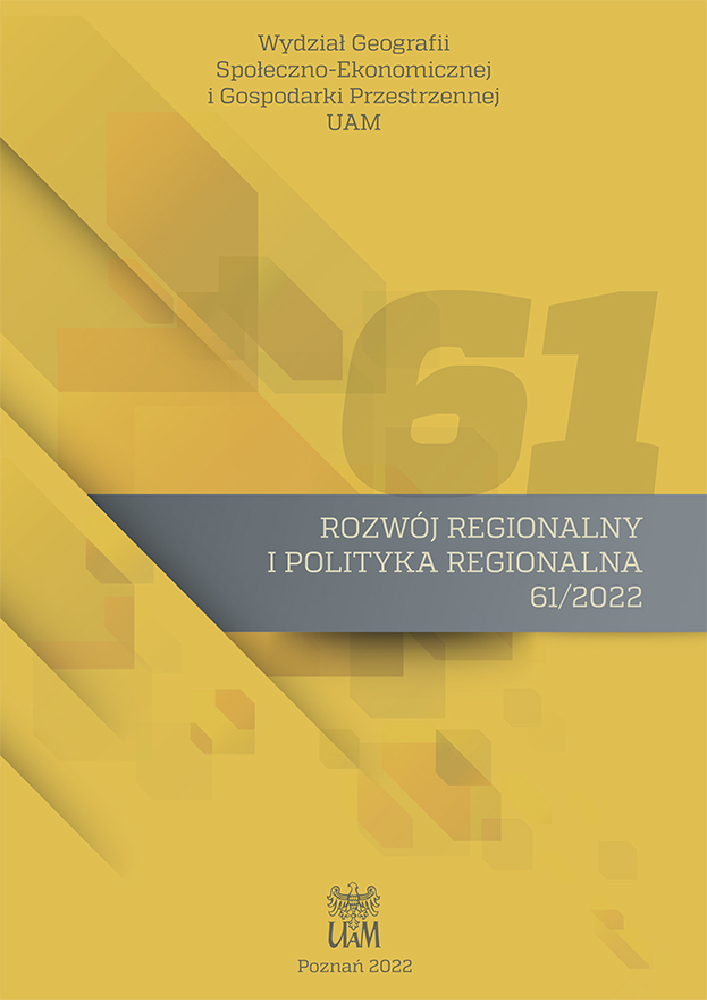Abstrakt
Celem artykułu jest ocena zróżnicowania przestrzennego efektu zazielenienia w Polsce w odniesieniu do terenów użytkowanych rolniczo na skutek wprowadzania „zielonych” płatności bezpośrednich. Próbowano znaleźć odpowiedź na sformułowane pytanie badawcze: w jakim stopniu wprowadzenie zazielenienia miało wpływ na ochronę bioróżnorodności terenów rolnych? Jako podstawę analizy przestrzennej tego działania przyjęto dwa wskaźniki, przedstawiające liczbę wniosków zrealizowanych w ramach zazielenienia w procencie ogólnej liczby gospodarstw rolnych powyżej 10 ha użytków rolnych oraz wielkość pozyskanej z tego tytułu kwoty w przeliczeniu na 1 ha użytków rolnych. Zakres przestrzenny analizy obejmował terytorium całego kraju, a jako podstawowe jednostki przyjęto regiony (województwa) oraz powiaty (w układzie 314 biur powiatowych Agencji Restrukturyzacji i Modernizacji Rolnictwa). Przeliczenia wskaźników dokonano w odniesieniu do ich przeciętnej dla lat 2017–2020 według wykazu producentów rolnych Agencji Restrukturyzacji i Modernizacji Rolnictwa. W badaniach zastosowano syntetyczny wskaźnik poziomu absorpcji płatności na zazielenienia. Wsparcie finansowe miało pozytywny wpływ na koncentrację użytków rolnych objętych dopłatami zazielenienia i widoczne było w północno-zachodniej i południowo-wschodniej Polsce. Z badań wynika, że na terenach rolnych, gdzie w większym stopniu wykorzystano instrumenty ekonomiczne sprzyjające zazielenieniu, rolnicy kontynuują ekstensywny sposób gospodarowania. Wpływa to korzystnie na zachowanie bioróżnorodności krajobrazów.
Bibliografia
da Silva J.M.C., Wheeler E. 2017. Ecosystems as infrastructure. Perspectives in Ecology and Conservation, 15(1): 32-35. https://doi.org/10.1016/j.pecon.2016.11.005 DOI: https://doi.org/10.1016/j.pecon.2016.11.005
Davies C., Hansen R., Rall E., Pauleit S., Lafortezza R., Yole De Bellis Y., Santos A., Tosics
I. 2015. Green Infrastructure Planning and Implementation (http://www.academia.edu/18650115/Green_Infrastructure_Planning_and_Implementation; dostęp: 5.02.2022).
European Commission 2013. Overview of CAP Reform 2014-2020. Agricultural Policy Perspectives Brief, 5*, December 2013.
Firehock K. 2010. A Short History of the Term Green Infrastructure and Selected Literature (http://www.gicinc.org/PDFs/GI%20History.pdf).
Hart K. 2015. Green direct payments: implementation choices of nine Member States and their environmental implications. IEEP, London.
Gocht A., Ciaian P., Bielza M., Terres J.-M., Röder N., Himics M., Salputra G. 2017. EU-Wide Economic and Environmental Impacts of CAP Greening with High Spatial and Farm-Type Detail. Journal of Agricultural Economics, 68(3): 651-681. https://doi.org/10.1111/1477-9552.12217 DOI: https://doi.org/10.1111/1477-9552.12217
Jaroszewska J., Prendecki K. 2016. Znaczenie "zazielenienia" zapewnienie różnorodności biologicznej. Zeszyty Naukowe SGGW, Problemy Rolnictwa Światowego, 16, 3: 110-120. https://doi.org/10.22630/PRS.2016.16.3.67 DOI: https://doi.org/10.22630/PRS.2016.16.3.67
Kaley H., Baldock D., Buckwell A. 2016. Learning the lessons of the Greening of the CAP. IEEP, London.
MRiRW 2021. Płatności z tytułu praktyk rolniczych korzystnych dla klimatu i środowiska (zazielenienie). Materiał informacyjny. Ministerstwo Rolnictwa i Rozwoju Wsi, Warszawa.
Pauleit S., Rieke H., Lorance Rall E., Zölch T., Andersson E., Luz A., Száraz L., Tosics I., Vierikko K. 2017. Urban landscapes and green infrastructure. [W:] Oxford Research Encyclopedia of Environmental Science. Oxford University Press, Oxford. https://doi.org/10.1093/acrefore/9780199389414.013.23 DOI: https://doi.org/10.1093/acrefore/9780199389414.013.23
Racine J.B., Reymond H. 1977. Analiza ilościowa w geografii. PWN, Warszawa.
Regulation (EU) No 1307/2013 of the European Parliament and of the Council of 17 December 2013 establishing rules for direct payments to farmers under support schemes within the framework of the common agricultural policy and repealing Council Regulation (EC) No 637/2008 and Council Regulation (EC) No 73/2009. OJ EU, 2013, L 347/608.
Regulation (EU) No 639/2014 of 11 March 2014 supplementing Regulation (EU) No 1307/2013 of the European Parliament and of the Council establishing rules for direct payments to farmers under support schemes within the framework of the common agricultural policy and amending Annex X to that Regulation. OJ EU, 2014.
Rolnictwo w 2020 roku. 2021. GUS. Warszawa.
Runge J. 2007. Metody badań w geografii społeczno-ekonomicznej - elementy metodologii, wybrane narzędzia badawcze. Wydawnictwo Uniwersytetu Śląskiego, Katowice.
Sprawozdanie z działalności ARiMR za rok 2020. 2021. Departament Analiz i Sprawozdawczości ARiMR, Warszawa.
Szulczewska B. 2018. Zielona infrastruktura czy koniec historii? Studia Komitetu Przestrzennego Zagospodarowania Kraju, 189.
Wąs A., Jaroszewska J., 2017. Pierwsze zmiany w polskim rolnictwie po wprowadzeniu mechanizmu "zazielenienia". Polityka ekonomiczna. Prace Naukowe Uniwersytetu Ekonomicznego we Wrocławiu, 487: 331-340. https://doi.org/10.15611/pn.2017.487.29 DOI: https://doi.org/10.15611/pn.2017.487.29
Wąs A., Zawalinska K., Britz W. 2014. Impact of "Greening" the Common Agricultural Policy: Evidence from Selected Countries Based on CAPRI model. Paper presented at the XIVth EAAE Congress: Agri-Food and Rural Innovations for Healthier Societies, Ljubljana, Slovenia.
Westhoek H., Overmars K.P., van Zeijts H. 2013. The provision of public goods by agriculture: Critical questions for effective and efficient policy making. Environmental Science & Policy, 32: 5-13.https://doi.org/10.1016/j.envsci.2012.06.015 DOI: https://doi.org/10.1016/j.envsci.2012.06.015
Volker M., Hubacek K., Coleby A. 2013. From polluter pays to provider gets: distribution of rights and costs under payments for ecosystem services. Ecology and Society, 18(4): 41. https://doi.org/10.5751/ES-06025-180441 DOI: https://doi.org/10.5751/ES-06025-180441
Zegar J.St. 2012. Współczesne wyzwania rolnictwa. Wydawnictwo PWN, Warszawa.
Licencja
Prawa autorskie (c) 2022 Anna Kołodziejczak, Krystian Koliński

Utwór dostępny jest na licencji Creative Commons Uznanie autorstwa 4.0 Międzynarodowe.

